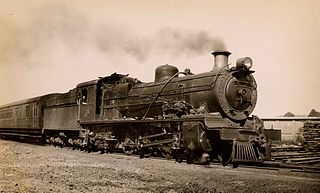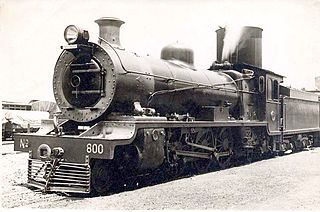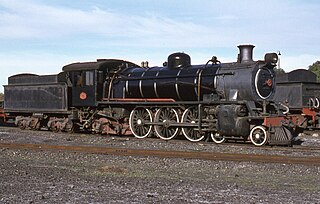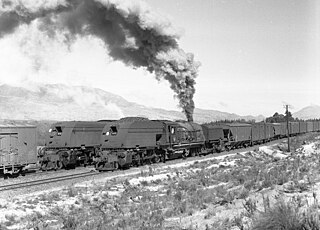Related Research Articles

Under the Whyte notation for the classification of steam locomotives, 4-6-2 represents the wheel arrangement of four leading wheels on two axles, six powered and coupled driving wheels on three axles and two trailing wheels on one axle. The 4-6-2 locomotive became almost globally known as a Pacific type after a New Zealand locomotive that was shipped across the Pacific Ocean.

Under the Whyte notation for the classification of steam locomotives, 4-8-2 represents the wheel arrangement of four leading wheels, eight powered and coupled driving wheels and two trailing wheels. This type of steam locomotive is commonly known as the Mountain type.

Under the Whyte notation for the classification of steam locomotives, 4-8-4 represents the wheel arrangement of four leading wheels on two axles, eight powered and coupled driving wheels on four axles and four trailing wheels on two axles. The type was first used by the Northern Pacific Railway, and initially named the Northern Pacific, but railfans and railroad employees have shortened the name since its introduction. It is most-commonly known as a Northern.

The Great Western Railway 2900 Class or Saint Class, which was built by the Great Western Railway's Swindon Works, incorporated several series of 2-cylinder passenger steam locomotives designed by George Jackson Churchward and built between 1902 and 1913 with differences in the dimensions. The majority of these were built as 4-6-0 locomotives; but thirteen examples were built as 4-4-2. They proved to be a highly successful class which established the design principles for GWR 2-cylinder classes over the next fifty years, and influenced similar classes on other British railways.

The Great Western Railway (GWR) 2800 Class is a class of Churchward-designed 2-8-0 steam locomotive.

The NBR C Class is a class of 0-6-0 steam locomotives designed by Matthew Holmes for freight work on the North British Railway (NBR). They were introduced in 1888 with inside cylinders and Stephenson valve gear. A total of 168 locomotives was built, of which 123 came into British Railways ownership at nationalisation in 1948. This was the last class of steam engine in service in Scotland.

The Dean Single, 3031 Class, or Achilles Class was a type of steam locomotive built by the British Great Western Railway between 1891 and 1899. They were designed by William Dean for passenger work. The first 30 members of the class were built as 2-2-2s of the 3001 Class.

The South African Railways Class 21 2-10-4 of 1937 was a class of steam locomotives used in South Africa.

The South African Railways Class 16C 4-6-2 of 1919 was a steam locomotive.

The South African Railways Class 16B 4-6-2 of 1917 was a steam locomotive.

The South African Railways Class 16 4-6-2 of 1914 was a steam locomotive.

The South African Railways Class 15F 4-8-2 of 1938 is a steam locomotive.

The South African Railways Class 5 4-6-2 of 1912 was a steam locomotive.

The South African Railways Class 4 4-8-2 of 1911 was a steam locomotive from the pre-Union era in the Cape of Good Hope.

The South African Railways Class GEA 4-8-2+2-8-4 of 1946 was an articulated steam locomotive.

The South African Railways Class GM 4-8-2+2-8-4 of 1938 was an articulated steam locomotive.

The Chicago and North Western R-1 class was a class of 325 4-6-0 "Ten-Wheeler" steam locomotives built by the Schenectady Locomotive Works, the American Locomotive Company, and the Baldwin Locomotive Works from 1901 to 1908. The R-1 locomotives were so large and so heavy that the Chicago and North Western (C&NW) Railroad had to extensively rebuild their trackage, bridges, tunnels, turntables, and enginehouses to accommodate them.
The Chicago and North Western Railway class Z was a class of 251 American 2-8-0 locomotives. They were built between 1909 and 1913, when production switched to the larger class J 2-8-2 locomotives. The class letter spawned their nickname amongst C&NW and Omaha Road crews: "Zulu".

The Chicago and North Western Railway D Class was a class of 92 American 4-4-2 "Atlantic" locomotives. They were built by Schenectady Locomotive Works and by its corporate successor the American Locomotive Company between 1900 and 1908. In addition, the Chicago, St. Paul, Minneapolis and Omaha Railway bought seven, classifying them as class G-3

The Milwaukee Road S3 Class was a class of 10 4-8-4 "Northern" type steam locomotives built by the American Locomotive Company in 1944 and operated by the Milwaukee Road until the mid 1950s. The locomotives saw service in pulling freight and passenger trains throughout the Milwaukee Road.
References
- ↑ Mailer (2004), p. 145.
- 1 2 Cole (1938), p. 72.
- ↑ Cole (1938), pp. 61–62.
- 1 2 Mailer (2004), p. 305.
- ↑ Drury (1985), p. 95.
- ↑ Chicago and North Western Railway (1948), p. 15.
- ↑ Chicago and North Western Railway (1948), pp. 14–17.
- Cole, F.A. (1938). Locomotives of the Chicago & North Western Railway. Boston: The Railway & Locomotive Historical Society.
- Chicago and North Western Railway (1948). Locomotives of the Chicago & North Western Railway, supplement. The Railway & Locomotive Historical Society.
- Drury, George H. (1985). The Historical Guide to North American Railroads. Milwaukee, Wisconsin: Kalmbach Publishing Company. ISBN 0-89024-072-8. LCCN 85080107.
- Mailer, Stan (2004). The Omaha Road: Chicago, St. Paul, Minneapolis & Omaha. Mukilteo, Washington: Hundman Publishing. ISBN 0-945434-04-9. OL 8448884M.
- Barrie, Wes. "Chicago & North Western / Chicago, St Paul, Minneapolis & Omaha 2-8-2 "Mikado" Locomotives in the USA". steamlocomotive.com. Retrieved 2020-05-01.